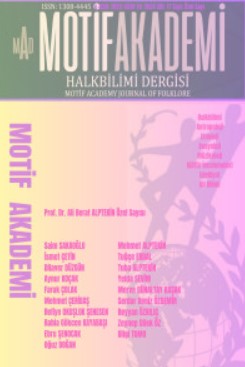SİLİFKE HALK KÜLTÜRÜNDE POYRAZ
POYRAZ IN SILIFKE FOLK CULTURE
Author(s): Mehmet AlptekinSubject(s): Cultural history, Customs / Folklore, Regional Geography
Published by: Motif Halk Oyunları Eğitim ve Öğretim Vakfı
Keywords: Silifke; Göksu valley; folk culture; north-eastern wind (poyraz); detection;
Summary/Abstract: Silifke is located in the Taşeli Section of the Mediterranean Region. The district is surrounded by Erdemli in the east, Mut and Gülnar districts in the west, Karaman province and Konya's Ereğli district in the north, and the Mediterranean Sea in the south. The district is located on important road routes and connects Mersin to the Central Anatolia Region. The fact that the district borders the Mediterranean and the Central Anatolia Region has increased the diversity of vegetation. Likewise, thanks to its location, animal husbandry, agriculture, tourism, transhumance, climate characteristics, etc. It is also rich in aspects. However, in addition to the opportunities provided by the district's location, there are also negative situations. Perhaps the most important of these is the north-eastern wind (poyraz), which is a type of wind that reaches the Mediterranean by following the Göksu valley from the Central Anatolia Region. The study aimed to determine the effect of northerly wind (poyraz) on folk culture and the study was limited to the Silifke district of Mersin. In the study where qualitative research method was adopted, data were obtained by interview method and document review. As a result of the study, it was concluded that the northern wind (poyraz), which has an important place in Silifke folk culture, finds a place in many folkloric elements, from animal husbandry to agriculture, from architecture to public health, from folk beliefs to folk literature products.
Journal: Motif Akademi Halkbilimi Dergisi
- Issue Year: 17/2024
- Issue No: Sp. Issue
- Page Range: 146-168
- Page Count: 23
- Language: Turkish

